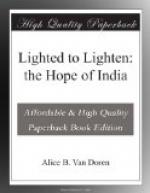Applied Sociology.
Certain parts of the curriculum also tie up closely with community life. Economics and essay writing lead into fields of research. Essays and contributions to the College magazine, “The Sunflower,” bear such titles as the “Social Needs of Kottayam District,” which goes into the causes of poverty and distress in the writer’s own locality, or “The Religion of the People of Kandy,” written by a convert from Buddhism who knows from her own childhood experience the beauties and defects of that great religious system.
An intercollegiate essay prize was won by a Christian college girl who wrote on her own home town, “The Superstitions and Customs of the Village of Namakal.” She writes:
“A set of villages would also be seen where the people are very much like the insects under a buried stone, which run underground, unable to see the light or to adapt themselves to the light. The moment the stone is turned up, so much accustomed are they to live in the darkness of superstition and unbelief that they think they would be better off to go on so, and refuse to accept the light rays of science, education, and civilization, which are willingly given them.”
The list of current omens and superstitions which she has unearthed may prove of interest to Western readers who have little idea of the burden of taboo under which the average Hindu passes his days. The essayist says:
“An attempt to enumerate these superstitious beliefs would be useless, but the following would illustrate the villagers’ deep regard for them, It is a good omen to hear a bell ring, an ass bray, or a Brahmini kite cry, when starting out to see a married woman whose husband is alive. They believe it to be an excellent omen to see a corpse, a bunch of flowers, water, milk, a toddy pot, or a washerman with dirty clothes, while setting out to give any present to her or her husband. No Hindu man or woman would set out to visit a newly married couple if he or she hears sneezing while starting, or proceed on the journey if he or she hears the wailing of a beggar, or happens to see a Brahmin widow, a snake, a full oil pot, or a cat.”
[Illustration: IN THE CLOISTER’S STUDIOUS SHADE]
[Illustration: MISS JACKSON AND SOME SOCIAL SERVICE WORKERS]
The College Woman and India.
Many of the students are full of ideas as to the various places which women may fill in the economy of the India of the future. Among the professions open to women, teaching is of course the favorite. Its opportunities are shown in the following:




